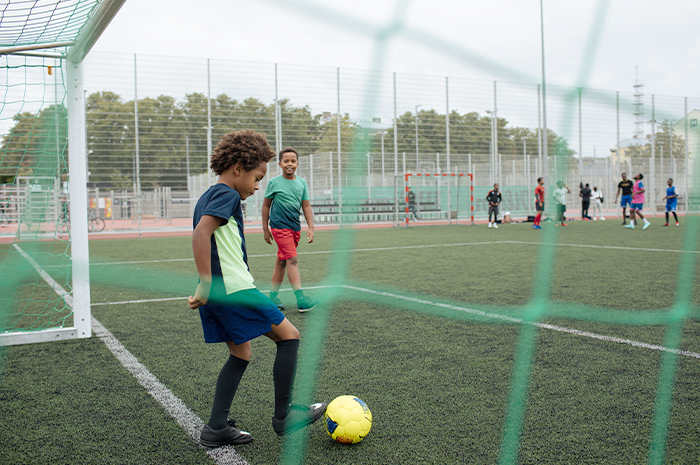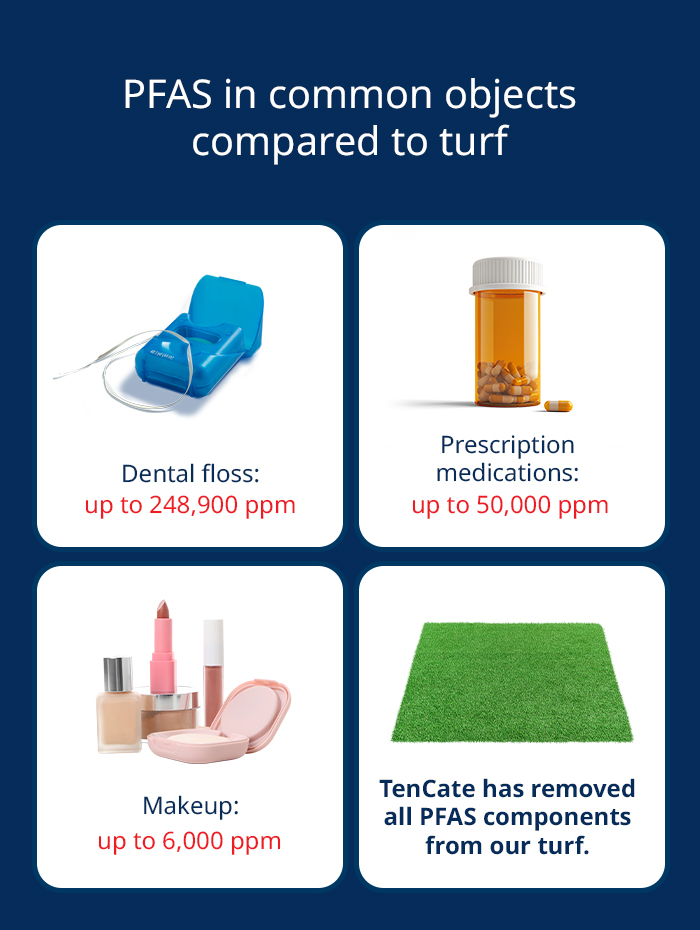CA Can’t Afford to Ban Play

The basics: what lawmakers and the public need to know
- First, turf is NOT a significant exposure point to PFAS.
- Second, turf is a solution for water scarcity – a major problem in California specifically. In a region facing drought and water restrictions, artificial turf saves between 500,000 to one million gallons of water per field per year. With over 20,000 turfed sports fields in the US, that’s approximately 10-20 billion gallons of water saved annually.
- Last, drought can lead to dry, hard and unplayable natural grass fields. Without turf as an alternative playing surface, sports will be put on hold. This means the ban on artificial turf could lead to dire consequences for our communities: participation in sports increases the likelihood of attending college, reduces crime and decreases instances of drug use in youth.

Setting the Record Straight: PFAS, Microplastics, Heat Island Effect and Recyclability
Turf is one of the last things we should focus on if we’re truly concerned about PFAS. PFAS are everywhere. But here’s the confounding thing: Our turf has a much lower risk of PFAS exposure than many items we willingly encounter daily— some of which we actually put on or in our bodies. TenCate turf is now manufactured entirely without PFAS, but even before that, it only measured at 100 parts per million.
Here are a few examples:
- Makeup
- Prescription medications
- Dental floss
- Nonstick cookware
- Raingear
- Contact lenses
- Fertilizers
- Insecticides
- Pesticides
- Fungicides
- Fish
- Water
- Soil
- Plants
- Rain

That’s not a typo. It actually rains PFAS.
What’s even more unreasonable is that these California turf ban makes a lot of assumptions about turf, banning the product entirely instead of regulating the undesired aspects. For instance, since October 2023, all TenCate turf is manufactured without PFAS, which should exclude it from bans founded on PFAS content.
But PFAS-related bans on artificial turf will ban all turf, regardless of PFAS content.
It doesn’t stop there. TenCate also answers other concerns noted in the California turf ban, like heat island effect, microplastics and recyclability. Our newest NO infill turf does not act as a heat sink like traditional artificial turf fields with tons of rubber infill. For places concerned with heat island effect, GeoCool™ is a field cooling solution. Plus, no-infill turf products reduce fiber degradation and microplastic shedding by doing away with abrasive infill that can potentially migrate off fields. And our advanced recycling partnership, the first of its kind in the US, means turf no longer ends its life in a landfill. Instead, it can be 100% recycled and turned into new products.
Effectively, we have turf that poses none of the problems that banning turf aims to solve. So why is it included in proposed bans?

When turf is banned, our communities lose.
While replacement costs and new maintenance requirements will be consequential realities of the ban for schools and municipalities, they aren’t the only negative impacts our communities will face. Artificial turf in California provides environmental benefits that natural grass just can’t as well as increases access to the social benefits that play brings. In California, water restrictions are likely to make the remaining fields (natural grass) hard, uneven and unsafe for athletes. Even well-maintained grass fields can’t support as many hours of use as turf can, which means athletes and children are going to lose access to play if a these turf bans pass.
And play matters. Physical activity contributes to overall well-being for participants, improving physical health and fitness and supporting mental and emotional wellness.
Our environment stands to lose too. Turf doesn’t need regular irrigation and won’t burden precious aquatic ecosystems with overuse or hazardous runoff from chemicals like pesticides and fertilizers (which contain — or are classified as — PFAS).
With new generations of turf that solve concerns around heat, microplastics, recyclability and PFAS, banning turf will only disservice our communities.
Hear from local community members.
 Alan Reising
Alan Reising
Assistant Superintendent- Facilities & Operations at Long Beach Unified School District
“As our communities continue to rely on public schools to support the recreational needs of our neighborhoods, our fields have become almost a 24/7 operation. School Districts need resilient, sustainable solutions that can withstand the type of rigorous use we put on our athletic fields. Simply put, natural grass field will not support our needs into the future. We need these solutions and I ask that you join me in opposing this ban.”
 Ted Walstrom
Ted Walstrom
Assistant Superintendent- Facilities and Governmental Relations at Santa Ana Unified School District
“With the Community Schools movement, our facilities and playfields are used many more hours per day than they were designed for. It is impossible to keep natural grass in playable shape without the proper recovery time. This ban will only remove opportunities for our youth to have safe surfaces to play on.”
 Paul Caliguiri
Paul Caliguiri
Diamond Bar / UCLA | 90 & 94 FIFA World Cups | US National Soccer Hall of Fame
“Proper synthetic turf offers athletes a secure, dependable, and uniform playing surface. Engineered to provide cushioning and support, it significantly reduces the risk of injuries from falls and impacts. Moreover, synthetic turf rigorously adheres to safety standards and regulations set by sports governing bodies.
Extensive testing has certified the safety of synthetic turf, which is made from non-toxic materials and devoid of harmful chemicals. Furthermore, artificial turf does not harbor allergens such as pollen or mold commonly found in natural grass.
Los Angeles possesses the opportunity to lead in water conservation efforts as a city situated in a region frequently plagued by water scarcity. It is imperative for Los Angeles to prioritize sustainable water management practices. Through the implementation of innovative strategies and the encouragement of community involvement, Los Angeles can become a beacon for other cities to emulate. Let’s unite and conserve water for a sustainable future on our planet.”

